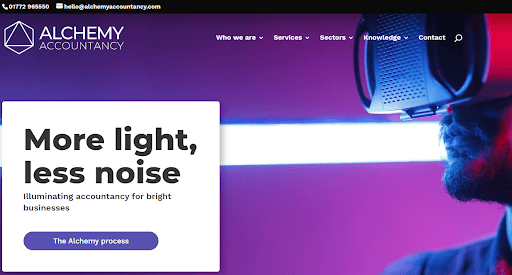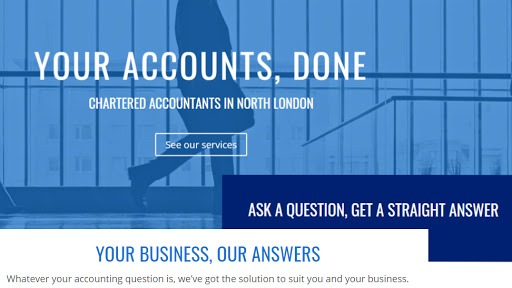Accountancy is a crowded market so it’s important for practices to find a way to stand out. At the same time, your firm’s brand identity and tone of voice must be authentic.
In other words, it must be a true reflection of your personality, or of your accounting firm’s culture and attitudes.
And if it’s truly unique, something that genuinely sets you apart from the rest, all the better.
“But I haven’t got a personality, nor has our firm,” you might say, as indeed some clients have said to us with self-deprecating humour.
Or, worse, you might not feel that your firm’s culture is anything worth shouting about, or lacks a point of difference – “we work with most sectors, really, and we don’t specialise in anything.”
That might point to a problem branding can’t solve and ideally, you’d fix that first, by taking the time to reflect on your goals and values in one of our brand strategy workshops.
The process of developing a brand strategy will help you identify what you want to do more of, what you want to jettison, and which clients you’d particularly like to attract – aka, buyer personas.
Clarity of vision goes a long way when it comes to creating a brand, pinpointing which aspects of your accountancy firm’s personality you want to dial up, and which ones you want to push into the background.
Brand identity
Think of your brand identity as the face you show the world: it should always be you or your accountancy practice on its best day.
Put yourself in a client’s shoes. If you were looking for an accountant, would you choose a practice with generic colours and typography, and washed-out images of tax returns piled up on their desk on a drab mid-January day? Probably not.
A brand that stands out for all the right reasons is far more likely to make waves in the market, both in terms of generating leads and gaining recognition within the industry.
Bold brands are not easy or quick to create, and a lot of thought and time needs to be invested by both the agency doing the work and the stakeholders to come up with long-lasting results, as was the case with with Alchemy, above.
The brand identity isn’t just the look and feel of your website – it sets the tone for all marketing materials. How would your brand express itself on the side of a bus, a business card, a Twitter header image, a coffee cup, or anywhere else you might want to display it?
It takes time and effort to create an authentic, durable brand and our process is often the first sniff accountants get of a brand strategy. It has to be said, it has been quite a culture shock for some of our clients.
Quite often, we’re faced with baffled looks at the start of the process – if you’re used to dealing in hard facts and carefully reconciled numbers, talking about values and personality can initially feel a bit, well, daft.
But the games we make people play, the apparently odd questions we ask, are all about unlocking what you already know about yourself and your brand and getting it out of your head.
In teaching and learning terms, we use these strategies to ‘elicit’ ideas about brand identity from you rather than dictate what we think it ought to be.
So, for example, when we ask, “If you had a TV ad, who would do the voiceover?” it’s partly because it’s fun, partly because when you reply, “Michael Parkinson” or “David Walliams” (two recent real examples) it unlocks ideas that might not otherwise have been easy to arrive at.
- Michael Parkinson – warm, authoritative, common sense.
- David Walliams – quick-witted, sharp, contemporary.
We feed all the words and ideas that spill out of the process into the mix and use them to synthesise something original that really does set you apart from your rivals, while still feeling like your voice.
Authenticity
You may think that marketing is by definition inauthentic. That might have been right 20 years ago, but in a digital age where people are generally more tech-savvy and questioning of the messages they receive, authenticity matters.
The more spare time we spend glued to our smartphones, the more we yearn for genuine experiences.
Don’t be afraid to acknowledge your firm’s weaknesses – just try to turn them into strengths.
For example, if you’re businesslike and process-driven, why not acknowledge that rather than struggling to portray yourself as ‘fun’?
After all, plenty of clients want business-like and process driven.
The point is, staying true to who you are, what you do and who you serve, is not only much easier – keeping up a pretence can be exhausting – but will also help you connect with clients who will feel the honesty in what you say.
By all means, ramp up the good bits about you or your practice and tone down the negative aspects. Just don’t pretend to be something you’re not or offer a product or service you’re not really equipped to deliver.
For example, PracticeWeb is always being asked for advice on social media, and between us we know plenty about it, but it’s not a service we offer (for the moment, at least) because that’s not where our real skill lies.
Readers should be able to relate to your business, understand clearly what you offer them, and believe that what you offer is of a genuinely high quality.
Only then can authenticity build your brand identity into something influential, elevate it above the competition, and add substance to your products and services.
Tone of voice
The other component of creating an authentic brand is tone of voice.
This is a subtle thing but no less powerful: a strong tone can resonate through design and content, knitting together your website, at an almost subconscious level.
One of our clients came to us with a mandate to create punchy, direct content to resonate with busy Londoners. We put our thinking caps on and thought of Ray Winstone – confident, plain-talking, assertive.
The copy used the same tone Winstone adopts when appearing in the ads that crop up during half-time of the football or rugby, or during the tea break of the Test match.
You can really hear him saying “Your accounts, done” and the client absolutely loved this no-nonsense, cockney tone of voice.
A quick exercise
- Look at your current website.
- Read the first chunk of copy aloud – does it sound like how you or your partners actually speak?
- Think of a celebrity figurehead, as in the examples above. Then rewrite that copy with them in mind.
To like and share this article, click below.






